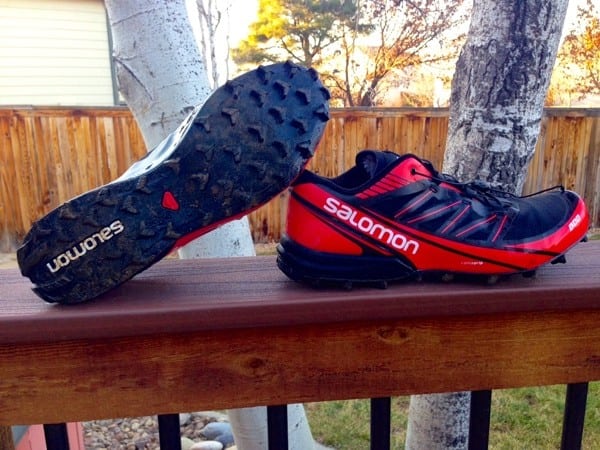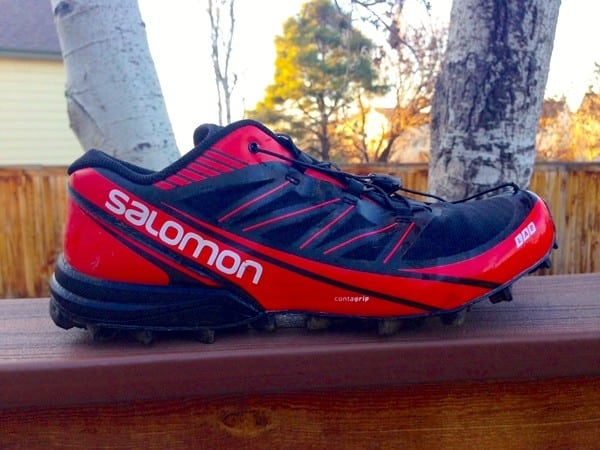Our Favorite Trail Running Shoes
Check out our Best Trail Running Shoes article to learn about our current favorite trail running shoes!
Salomon S-Lab Fellcross 3 Review
If your late-winter and early-spring runs are causing you to sing the old Simon and Garfunkel tune, “Slip sliiiiiiiiiiding away…,” then it’s time to check out the Salomon S-Lab Fellcross 3 ($170). These trail running shoes will revolutionize your muddy, mucky, wet, snowy, slippery, sketchy trail experiences and have you dancing up and down the hills nimbly while leaving the gunk behind.
The S-Lab Fellcross 3 is a 300-gram (9.2 ounces for men’s size 9) unisex shoe with a 4mm drop and a low-profile design (9mm stack height in the heel, 5mm in the forefoot). This updated version shaves an additional ounce off compared to the Fellcross 2 and features improved prevention of moisture absorption while retaining the breathability important for shoes designed for these conditions. The S-Lab series shoes are definitely top of the line. I tested these shoes in hard-pack snow and over-the-shoe slush, mucky mud and clay, hard pack, rocky dirt, and 10 inches of fresh powder on top of unconsolidated mud that can only be described as “squidgy.” (Thanks, British friends for that word.)

The Salomon S-Lab Fellcross 3. All photos: iRunFar/Kristin Zosel
Upper
The upper is a sleek ripstop nylon very similar, if not identical, to that found on the Salomon Speedcross. Though it’s not the Climashield weather-resistant material featured on shoes like the Salomon Snowcross and Speedcross CS, it’s excellent in keeping debris like sand, dust, and powdery snow out. It’s also significantly more water resistant than the open mesh found on the similar Salomon Fellraiser. I found it to drain decently during my slushy runs (no lingering bogginess), and the shoe was always dry by the time I ran the next day. I’m not sure how the breathability would be affected in temperatures above 60 degrees Fahrenheit. The few times I ran when it was that warm, my feet were still in slush and muck, so heat retention was something I was wishing for.
The welded overlays blend seamlessly into the rand that extends up from the outsole to prevent water and debris from entering at that junction. I thoroughly appreciate this feature for mucky and snowy runs, and it didn’t seem to prevent quick drainage from inside the shoe. The overlays combined with the internal sleeve and the Quicklace system cradled my foot snugly and kept my foot in place even on steeper downhills. Never once did the insole creep in any direction regardless of the terrain, nor did my toes migrate to the bumper. The protective TPU toe cap is substantial but lightweight as is the firm heel cup. Again, I loved these features as I had no toe soreness from the occasional kicked rock and the shoe is very stable on uncompromising terrain.
The tongue of the shoe has minimal padding and is very stable with unobtrusive gussets extending from the top eyelet to the platform of the shoe. It’s further held in place with a thin ribbon of fabric connecting it to the most anterior overlay at the beginning of the laces and lies under a thin layer of anti-debris mesh. It’s one more outstanding addition to prevent “nature” from coexisting with your foot inside the shoe. Lastly, the lace pocket sits on the front of the tongue just before the laces cinch. It seems they’ve improved the positioning of this as it is more easily accessible. I still tend not to use it because I just route the long lace under the most forward loop on the shoe—personal preference.

The Salomon S-Lab Fellcross 3 lateral upper.
Midsole
The midsole is a compressed, molded EVA which provides ample protection and cushioning for the terrain it was designed for. It’s not a shoe you put on and think, Oh, how cushy. It’s also not a shoe I’d choose for consistent hard pack. It’s a shoe that makes you feel like a super star ascending and descending steep, slippery hills with expert agility—or at least with more expertise than you’d have otherwise. The molded and shaped Ortholite footbed adds more comfort to the interior and stayed in place exceptionally well. It was also easy to get in and out of the shoe to speed drying. I didn’t notice any issues with retained water or smell with this particular footbed.

The Salomon S-Lab Fellcross 3 medial upper.
Outsole
The Fellcross 3 is built on Salomon’s “fell run last” which in layman’s terms means it’s cut with minimal to no “flare” at the heel or forefoot. It matches the width of the foot exactly. For comparison’s sake, the widest part of the outsole on the heel of my Speedcross 3’s is 3.5 inches compared to 3 inches on the Fellcross 3. The widest part of the outsole on the forefoot of the Speedcross 3 is 4 inches compared to 3.5 inches on the Fellcross 3. These are by far the most narrow feeling of the four styles of Salomons I’ve worn. I even went up a half size because I feared the narrowness might leave no room for my fifth toe. I’m not sure that was necessary, but I’m fine in the larger size. Despite the narrower footprint, I had no issues with falling off of the edges of the shoe on technical terrain. The Mud&Snow Non-Marking Contagrip on the one-quarter inch lugs is outstanding for grip in wintery conditions. There’s an average of one to two extra lugs across the width of the shoe compared to the Speedcross. Additionally, each lug has a sharper chevron pattern with two sipes to improve traction on muddy or wet rock (like winter tires). They shed the mud and snow faster than any other shoe I have, even the clay-mud. Though I’d not prefer to spend a significant amount of time on rocks or hard-pack dirt in these shoes due to the relatively minimal cushioning, it’s not at all a problem to encounter them on and off during a run.

The Salomon S-Lab Fellcross 3 outsole.
Overall Impressions
Because my foot likes the Salomon fit, I’d be hard pressed to find another shoe that would excel in the mud, muck, snow, and slush on mountain trails like the Salomon S-Lab Fellcross 3. My biggest challenge is the narrowness of the fit which precludes any sock but my standard Drymax Light Trail running socks. I have no extra room for a warmer Merino wool sock or even the Drymax winter-weight sock. Strangely, this isn’t a problem for my feet up to 2.5 hours in the aforementioned conditions. I’m not sure how it would be if I was out there longer. I’d likely switch to my women’s Speedcross for longer runs as I have a bit more room without sacrificing too much on the traction. I also had a bit of a challenge with how deep my foot sat in the shoe. While I liked being close to the ground, on really uneven terrain my outside ankle bones (lateral malleolus) took a bit of a beating. I attribute this to the “unisex” sizing versus a true women’s-cut shoe.
These shoes will excel in the muddy mountain trails of the Pacific Northwest, the slush and clay of the Midwest, the steep and mucky vertical in the East, and the boggy fells in the U.K. and beyond. I love them here in Colorado for the variable winter conditions we often have as the sun fights with snow. I hope Salomon will continue to expand their S-Lab line to include women’s-specific shoes across the board.
Call for Comments (from Meghan)
- Have you run in the Salomon S-Lab Fellcross 3? What are your thoughts on its performance on the slick and muddy substrates for which it was designed?
- If you ran in previous versions of the Fellcross, what do you think of the updates Salomon has made to this model?
- Have you run in other Salomon shoes? If so, how does the the Fellcross 3 compare to some of those other shoes?
- Finally, are you a woman wearing one of the S-Lab unisex shoes? Does your foot and body like the unisex design? Do you have issues in these shoes that you don’t in gender-specific shoes?
